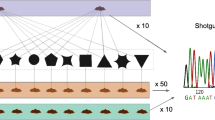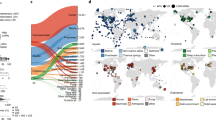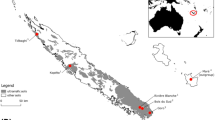Abstract
The phylogenetic resolution at which microorganisms display geographic endemism, the rates at which they disperse at global scales, and the role of humans on global microbial dispersal are largely unknown. Answering these questions is necessary for interpreting microbial biogeography, ecology, and macroevolution and for predicting the spread of emerging pathogenic strains. To resolve these questions, I analyzed the geographic and evolutionary relationships between 36,795 bacterial and archaeal (“prokaryotic”) genomes from ∼7000 locations around the world. I find clear signs of continental-scale endemism, including strong correlations between phylogenetic divergence and geographic distance. However, the phylogenetic scale at which endemism generally occurs is extremely small, and most “species” (defined by an average nucleotide identity ≥ 95%) and even closely related strains (average nucleotide identity ≥ 99.9%) are globally distributed. Human-associated lineages display faster dispersal rates than other terrestrial lineages; the average net distance between any two human-associated cell lineages diverging 50 years ago is roughly 580 km. These results suggest that many previously reported global-scale microbial biogeographical patterns are likely the result of recent or current environmental filtering rather than geographic endemism. For human-associated lineages, estimated transition rates between Europe and North America are particularly high, and much higher than for non-human associated terrestrial lineages, highlighting the role that human movement plays in global microbial dispersal. Dispersal was slowest for hot spring- and terrestrial subsurface-associated lineages, indicating that these environments may act as “isolated islands” of microbial evolution.
Similar content being viewed by others
Log in or create a free account to read this content
Gain free access to this article, as well as selected content from this journal and more on nature.com
or
Data availability
All data are available as supplementary material and on public repositories (accession numbers in Supplementary File 1).
Code availability
All software used in this paper have been described in the Methods and are freely available online.
References
Kruckeberg AR, Rabinowitz D. Biological aspects of endemism in higher plants. Annu Rev Ecol Syst. 1985;16:447–79.
Ceballos G, Brown JH. Global patterns of mammalian diversity, endemism, and endangerment. Conserv Biol. 1995;9:559–68.
Mueller GM, Schmit JP, Leacock PR, Buyck B, Cifuentes J, Desjardin DE, et al. Global diversity and distribution of macrofungi. Biodivers Conserv. 2007;16:37–48.
Prideaux GJ, Warburton NM. An osteology-based appraisal of the phylogeny and evolution of kangaroos and wallabies (macropodidae: Marsupialia). Zool J Linn Soc. 2010;159:954–87.
Finlay BJ, Clarke KJ. Ubiquitous dispersal of microbial species. Nature. 1999;400:828.
Whitaker RJ, Grogan DW, Taylor JW. Geographic barriers isolate endemic populations of hyperthermophilic archaea. Science. 2003;301:976–978.
Whitfield J. Is everything everywhere? Science. 2005;310:960–61.
Boenigk J, Pfandl K, Garstecki T, Harms H, Novarino G, Chatzinotas A. Evidence for geographic isolation and signs of endemism within a protistan morphospecies. Appl Environ Microbiol. 2006;72:5159–64.
DeWit R, Bouvier T. ‘Everything is everywhere, but, the environment selects’; what did Baas Becking and Beijerinck really say? Environ Microbiol. 2006;8:755–8.
van der Gast CJ. Microbial biogeography: the end of the ubiquitous dispersal hypothesis? Environ Microbiol. 2015;17:544–6.
Whittaker KA, Rynearson TA. Evidence for environmental and ecological selection in a microbe with no geographic limits to gene flow. Proc Natl Acad Sci USA. 2017;114:2651–56.
Louca S, Shih PM, Pennell MW, Fischer WW, Parfrey LW, Doebeli M. Bacterial diversification through geological time. Nat Ecol Evol. 2018;2:1458–67.
Martiny JBH, Bohannan BJ, Brown JH, Colwell RK, Fuhrman JA, Green JL, et al. Microbial biogeography: putting microorganisms on the map. Nat Rev Microbiol. 2006;4:102–12.
Martiny JBH, Eisen JA, Penn K, Allison SD, Horner-Devine MC. Drivers of bacterial β-diversity depend on spatial scale. Proc Natl Acad Sci USA. 2011;108:7850–54.
Jungblut AD, Lovejoy C, Vincent WF. Global distribution of cyanobacterial ecotypes in the cold biosphere. ISME J. 2010;4:191–202.
Gibbons SM, Caporaso JG, Pirrung M, Field D, Knight R, Gilbert JA. Evidence for a persistent microbial seed bank throughout the global ocean. Proc Natl Acad Sci USA. 2013;110:4651–55.
Ramirez KS, Leff JW, Barberán A, Bates ST, Betley J, Crowther TW, et al. Biogeographic patterns in below-ground diversity in New York City’s Central Park are similar to those observed globally. Proc R Soc Lond B Biol Sci. 2014;281:20141988.
Gonnella G, Böhnke S, Indenbirken D, Garbe-Schönberg D, Seifert R, Mertens C, et al. Endemic hydrothermal vent species identified in the open ocean seed bank. Nat Microbiol. 2016;1:16086 EP.
Louca S, Mazel F, Doebeli M, Parfrey WL. A census-based estimate of Earth’s bacterial and archaeal diversity. PLoS Biol. 2019;17:e3000106.
Ochman H, Wilson A. Evolution in bacteria: evidence for a universal substitution rate in cellular genomes. J Mol Evol. 1987;26:74–86.
Kuo CH, Ochman H. Inferring clocks when lacking rocks: the variable rates of molecular evolution in bacteria. Biol Direct. 2009;4:35–35.
Roberts MS, Cohan FM. Recombination and migration rates in natural populations of Bacillus subtilis and Bacillus mojavensis. Evolution. 1995;49:1081–94.
van Gremberghe I, Leliaert F, Mergeay J, Vanormelingen P, Van der Gucht K, Debeer AE, et al. Lack of phylogeographic structure in the freshwater cyanobacterium Microcystis aeruginosa suggests global dispersal. PLoS ONE. 2011;6:e19561.
Papke RT, Ramsing NB, Bateson MM, Ward DM. Geographical isolation in hot spring cyanobacteria. Environ Microbiol. 2003;5:650–9.
Hongmei J, Aitchison JC, Lacap DC, Peerapornpisal Y, Sompong U, Pointing SB. Community phylogenetic analysis of moderately thermophilic cyanobacterial mats from China, the Philippines and Thailand. Extremophiles. 2005;9:325–32.
Miller SR, Castenholz RW, Pedersen D. Phylogeography of the thermophilic cyanobacterium Mastigocladus laminosus. Appl Environ Microbiol. 2007;73:4751–59.
Takacs-Vesbach C, Mitchell K, Jackson-Weaver O, Reysenbach AL. Volcanic calderas delineate biogeographic provinces among Yellowstone thermophiles. Environ Microbiol. 2008;10:1681–89.
Reno ML, Held NL, Fields CJ, Burke PV, Whitaker RJ. Biogeography of the Sulfolobus islandicus pan-genome. Proc Natl Acad Sci USA. 2009;106:8605–10.
Bahl J, Lau MCY, Smith GJD, Vijaykrishna D, Cary SC, Lacap DC, et al. Ancient origins determine global biogeography of hot and cold desert cyanobacteria. Nat Commun. 2011;2:163.
Anderson RE, Kouris A, Seward CH, Campbell KM, Whitaker RJ. Structured populations of Sulfolobus acidocaldarius with susceptibility to mobile genetic elements. Genome Biol Evol. 2017;9:1699–710.
Podar PT, Yang Z, Björnsdóttir SH, Podar M. Comparative analysis of microbial diversity across temperature gradients in hot springs from Yellowstone and Iceland. Front Microbiol. 2020;11:1625.
Clark K, Karsch-Mizrachi I, Lipman DJ, Ostell J, Sayers EW. Genbank. Nucleic Acids Res. 2015;44:D67–D72.
Konstantinidis KT, Tiedje JM. Genomic insights that advance the species definition for prokaryotes. Proc Natl Acad Sci USA. 2005;102:2567–72.
Kim M, Oh HS, Park SC, Chun J. Towards a taxonomic coherence between average nucleotide identity and 16S rRNA gene sequence similarity for species demarcation of prokaryotes. Int J Syst Evol Microbiol. 2014;64:346–51.
Olm MR, Crits-Christoph A, Diamond S, Lavy A, Carnevali PBM, Banfield JF. Consistent metagenome-derived metrics verify and delineate bacterial species boundaries. mSystems. 2020;5:e00731-19.
Jain C, Rodriguez-R LM, Phillippy AM, Konstantinidis KT, Aluru S. High throughput ANI analysis of 90K prokaryotic genomes reveals clear species boundaries. Nat Commun. 2018;9:5114.
Shapiro BJ. What microbial population genomics has taught us about speciation. In: Polz MF, Rajora OP, editors. Population Genomics: Microorganisms. Cham, Switzerland: Springer International Publishing; 2019. p. 31–47.
Parks DH, Chuvochina M, Waite DW, Rinke C, Skarshewski A, Chaumeil PA, et al. A standardized bacterial taxonomy based on genome phylogeny substantially revises the tree of life. Nat Biotechnol. 2018;36:996–1004.
Chaumeil PA, Mussig AJ, Hugenholtz P, Parks DH. GTDB-Tk: a toolkit to classify genomes with the Genome Taxonomy Database. Bioinformatics 2020;36:1925–27.
Felsenstein J. Phylogenies and the comparative method. Am Nat. 1985;125:1–15.
Louca S. Phylogeographic estimation and simulation of global diffusive dispersal. Syst Biol. 2021;70:340–59.
Comas I, Coscolla M, Luo T, Borrell S, Holt KE, Kato-Maeda M, et al. Out-of-Africa migration and Neolithic coexpansion of Mycobacterium tuberculosis with modern humans. Nat Genet. 2013;45:1176–82.
Denef VJ, Banfield JF. In situ evolutionary rate measurements show ecological success of recently emerged bacterial hybrids. Science. 2012;336:462–6.
Bouckaert R, Cartwright R. Phylogeography by diffusion on a sphere: whole world phylogeography. PeerJ. 2016;4:e2406.
Brillinger DR. A particle migrating randomly on a sphere. In: Selected Works of David Brillinger. Cham, Switzerland: Springer; 2012. p. 73–87.
Ghosh A, Samuel J, Sinha SA. “Gaussian” for diffusion on the sphere. Europhys Lett. 2012;98:30003.
Castenholz RW. The biogeography of hot spring algae through enrichment cultures. SIL Commun. 1978;21:296–315. 1953-1996
Valentine DL. Adaptations to energy stress dictate the ecology and evolution of the archaea. Nat Rev Micro. 2007;5:316–23.
Louca S, Parfrey LW, Doebeli M. Decoupling function and taxonomy in the global ocean microbiome. Science. 2016;353:1272–77.
Smith DJ, Jaffe DA, Birmele MN, Griffin DW, Schuerger AC, Hee J, et al. Free tropospheric transport of microorganisms from Asia to North America. Micro Ecol. 2012;64:973–85.
Pagel M. Detecting correlated evolution on phylogenies: a general method for the comparative analysis of discrete characters. Proc R Soc Lond B Biol Sci. 1994;255:37–45.
Whitman WB, Coleman DC, Wiebe WJ. Prokaryotes: the unseen majority. Proc Natl Acad Sci USA. 1998;95:6578–83.
Anderson D. The regulation of fishing and related activities in exclusive economic zones. In: Modern Law Sea, Publications on Ocean Development, vol. 59, chap. 11. Leiden, The Netherlands: Brill Nijhoff; 2008. p. 209–27.
Bullock JM, Clarke RT. Long distance seed dispersal by wind: measuring and modelling the tail of the curve. Oecologia. 2000;124:506–21.
Brynjarsdóttir J, O’Hagan A. Learning about physical parameters: the importance of model discrepancy. Inverse Probl. 2014;30:114007.
Bell T. Experimental tests of the bacterial distance-decay relationship. ISME J. 2010;4:1357–65.
Hyatt D, Chen GL, LoCascio PF, Land ML, Larimer FW, Hauser LJ. Prodigal: prokaryotic gene recognition and translation initiation site identification. BMC Bioinforma. 2010;11:119.
Parks DH, Imelfort M, Skennerton CT, Hugenholtz P, Tyson GW. Assessing the quality of microbial genomes recovered from isolates, single cells, and metagenomes. Genome Res. 2014;25:1043–55.
Chambat F, Valette B. Mean radius, mass, and inertia for reference Earth models. Phys Earth Planet Inter. 2001;124:237–53.
Data NS, (SEDAC) AC Gridded Population of the World, Version 4 (GPW v4): Population Density, Revision 11. Tech. rep., Palisades, NY: Center for International Earth Science Information Network - CIESIN - Columbia University. 2018. Accessed November 23, 2020.
Price MN, Dehal PS, Arkin AP. FastTree 2: approximately maximum-likelihood trees for large alignments. PLoS ONE. 2010;5:e9490.
Britton T, Anderson CL, Jacquet D, Lundqvist S, Bremer K. Estimating divergence times in large phylogenetic trees. Syst Biol. 2007;56:741–52.
Zhu Q, Mai U, Pfeiffer W, Janssen S, Asnicar F, Sanders JG, et al. Phylogenomics of 10,575 genomes reveals evolutionary proximity between domains bacteria and archaea. Nat Commun. 2019;10:5477.
Perrin F. Étude mathématique du movement brownien de rotation. In: Annales scientifiques del’École Normale Supérieure, vol. 45. Paris, France: Elsevier; with 1928. p. 1–51.
Louca S, Doebeli M. Efficient comparative phylogenetics on large trees. Bioinformatics. 2018;34:1053–55.
Bloomquist EW, Lemey P, Suchard MA. Three roads diverged? routes to phylogeographic inference. Trends Ecol Evol. 2010;25:626–32.
Lemey P, Rambaut A, Welch JJ, Suchard MA. Phylogeography takes a relaxed random walk in continuous space and time. Mol Biol Evol. 2010;27:1877–85.
Faria NR, Suchard MA, Rambaut A, Lemey P. Toward a quantitative understanding of viral phylogeography. Curr Opin Virol. 2011;1:423–9.
Faria NR, Suchard MA, Abecasis A, Sousa JD, Ndembi N, Bonfim I, et al. Phylodynamics of the HIV-1 CRF02_AG clade in Cameroon. Infect Genet Evol. 2012;12:453–60.
Lange K. Diffusion processes. In: Applied Probability, chap. 11. New York, NY: Springer New York; 2010. p. 269–95.
Ondov BD, Treangen TJ, Melsted P, Mallonee AB, Bergman NH, Koren S, et al. Mash: fast genome and metagenome distance estimation using minhash. Genome Biol. 2016;17:132.
Pasolli E, Asnicar F, Manara S, Zolfo M, Karcher N, Armanini F, et al. Extensive unexplored human microbiome diversity revealed by over 150,000 genomes from metagenomes spanning age, geography, and lifestyle. Cell 2019;176:649–62.
Criscuolo A, Gascuel O. Fast NJ-like algorithms to deal with incomplete distance matrices. BMC Bioinforma. 2008;9:166.
Paradis E, Claude J, Strimmer K. APE: analyses of phylogenetics and evolution in R language. Bioinformatics. 2004;20:289–90.
Kinene T, Wainaina J, Maina S, Boykin LM, Kliman RM. Methods for rooting trees, vol. 3. Oxford: Academic Press; 2016. p. 489–93.
van Rossum G. Python tutorial. Tech. Rep. CS-R9526, Amsterdam: Centrum voor Wiskunde en Informatica (CWI); 1995.
Acknowledgements
SL was supported by a startup grant by the University of Oregon. The author thanks Qusheng Jin for valuable comments.
Author information
Authors and Affiliations
Contributions
All work was performed by S.L.
Corresponding author
Ethics declarations
Competing interests
The author declares no competing interests.
Additional information
Publisher’s note Springer Nature remains neutral with regard to jurisdictional claims in published maps and institutional affiliations.
Supplementary information
Rights and permissions
About this article
Cite this article
Louca, S. The rates of global bacterial and archaeal dispersal. ISME J 16, 159–167 (2022). https://doi.org/10.1038/s41396-021-01069-8
Received:
Revised:
Accepted:
Published:
Issue date:
DOI: https://doi.org/10.1038/s41396-021-01069-8
This article is cited by
-
Ecophysiology and global dispersal of the freshwater SAR11-IIIb genus Fontibacterium
Nature Microbiology (2025)
-
Decoding populations in the ocean microbiome
Microbiome (2024)
-
Taxonomic variability and functional stability across Oregon coastal subsurface microbiomes
Communications Biology (2024)
-
A genus in the bacterial phylum Aquificota appears to be endemic to Aotearoa-New Zealand
Nature Communications (2024)
-
Genome-guided isolation of the hyperthermophilic aerobe Fervidibacter sacchari reveals conserved polysaccharide metabolism in the Armatimonadota
Nature Communications (2024)



